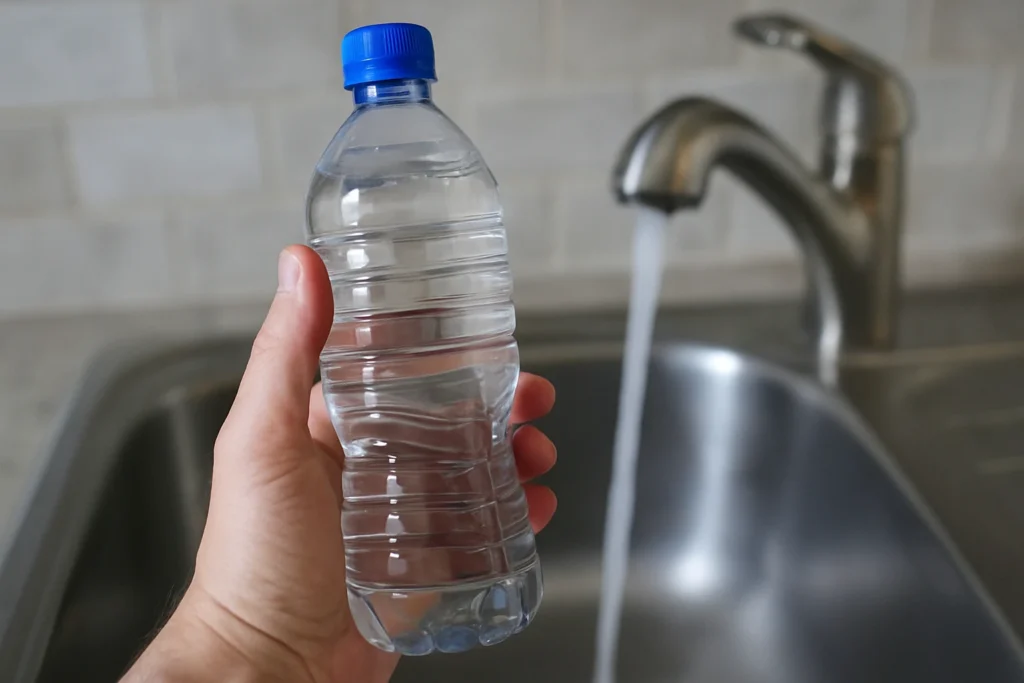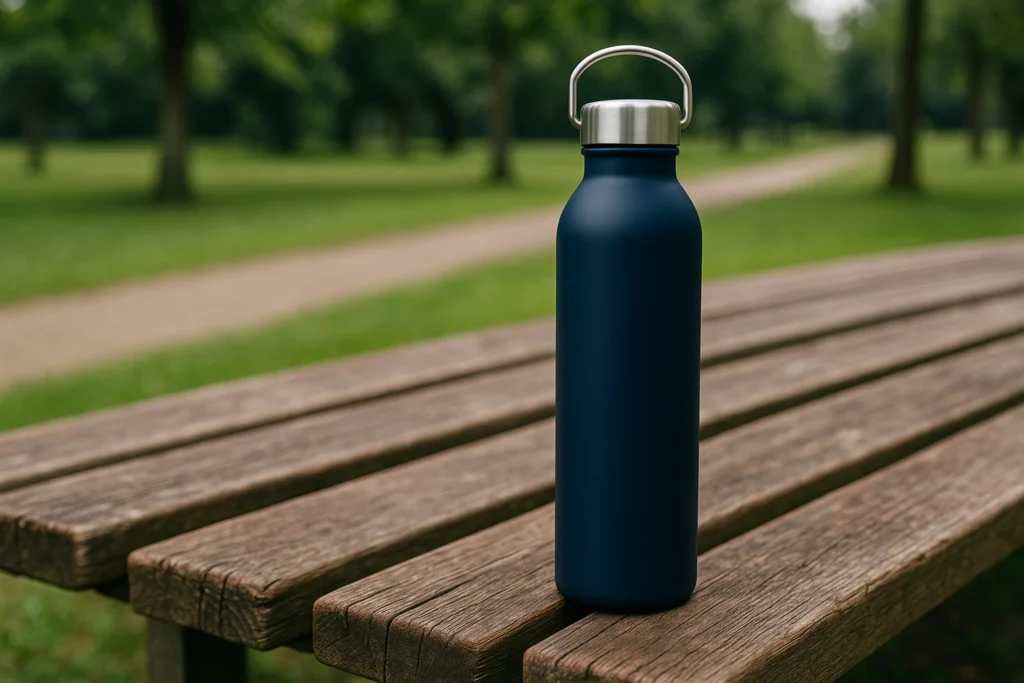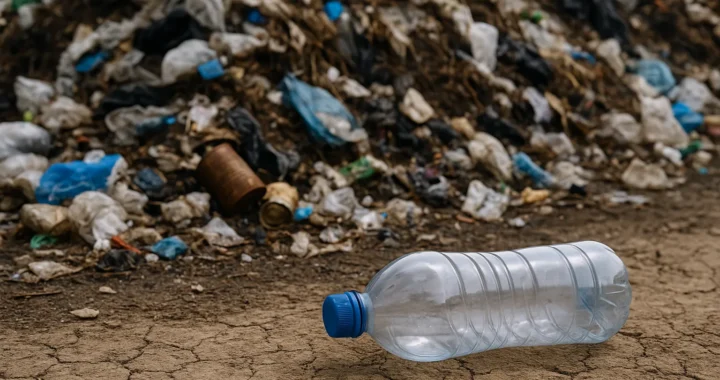You’ve been told bottled water is cleaner, safer, and better. But the truth is, it’s not. While it’s a necessity in some countries with unsafe water, in many areas, like Australia, it’s just a habit.
It’s a cleverly marketed illusion that costs you more, gives you less, and leaves behind a mountain of plastic waste. What you’re really buying is a single-use convenience with a centuries-long consequence.
Think about it. While your tap water (often just as safe) is readily available at home or work, you reach for bottled water because it’s easy, familiar, and packaged to look “pure.” But behind that convenience lies oil extraction, carbon emissions, plastic pollution, and an industry designed to profit off your doubt.
Billions fall for the same trap every year. But this is one habit you can change easily and with real impact.
Let’s talk about what bottled water is really doing to the planet and to you.
Why Bottled Water Pollution Is a Major Problem
Think one bottle doesn’t matter? Every single-use bottle contributes to a growing crisis that is choking our planet. The plastic used in bottled water can take centuries to degrade. In many cases, it doesn’t degrade at all, ending up in ocean currents or buried in landfills.
Each bottle begins in an oil field, where fossil fuels are extracted. It’s then:
- Moulded into shape
- Filled and sealed
- Shipped across cities or even continents
Every step of making bottled water uses up energy and adds carbon to the air. And in the end, it’s all for something that gets used once and tossed.
Most bottles don’t get a second life. In fact, only about 9 percent are ever recycled. The rest linger in the environment, slowly breaking apart. That bottle you tossed after lunch may still be around long after you’re gone, contaminating soil, waterways, and wildlife habitats.
When plastic doesn’t go away, nature pays the price:
- Sea birds are found with stomachs full of plastic.
- Marine animals choke on fragments or starve from ingesting them.
- Microplastics are now turning up in drinking water, seafood, and even human blood.
What we’re dealing with is bottled water waste and an industry optimised for speed and sales, leaving behind damage that no recycling bin can fix.
Every plastic bottle reminds us that a million bottles are sold globally every minute. Yet over 90 percent never get recycled. Most of that plastic will stick around for more than 400 years. And compared to tap water, bottled water has a carbon footprint that’s about 1,000 times higher.
When we talk about the cost of bottled water, this is the real price.
So, what about the financial cost, and what are we really paying for with every bottle we buy?
The Hidden Expenses Behind Bottled Water
Bottled water can cost up to 2,000 times more than what flows from your tap. In Australia, it often sells for over $5 a litre (making it the priciest worldwide!), while tap water costs less than a cent. It’s one of the biggest markups in the modern world and more expensive, in some cases, than petrol.
And yet, people buy it without blinking. That’s the power of convenience wrapped in marketing. So, what’s the real price of bottled water?
You’re paying for the water itself, along with things like branding, packaging, refrigeration, and transportation. All of these add up to make the water feel premium. These extras pad the pockets of corporations, while the long-term consequences are left to public systems.
What you’re really funding:
- Marketing campaigns and glossy labels
- Single-use plastic production and freight
- In-store refrigeration and retail markup
Taxpayers end up paying for waste management and recycling programmes that often can’t keep up. Local councils spend millions cleaning up litter. And as microplastics spread through our environment, new health concerns are putting extra strain on healthcare systems.
Even if you never touch a bottle, you’re still helping to pay for the damage.
So what are you really paying for? A clean, simple drink, or a system that profits from pollution?
And yet, despite all of this (the cost, the waste, the pollution), bottled water continues to fly off the shelves. Why? Let’s look at the myths, fears, and habits that keep the cycle going.
The Truth Behind Why Bottled Water Remains Popular
If we know bottled water is overpriced, wasteful, and harmful, why do people still buy it?
Because bottled water isn’t only sold as a product. People are drawn by the feeling of safety it offers, and that’s a powerful motivator. Over time, that feeling of safety and ease has become a big part of how we see water.

Here’s how:
Perception Over Reality
For years, bottled water brands have spent millions sending one clear message: their water is purer, safer, and better. They use pictures of alpine springs and melting glaciers to connect with our feelings, especially around health.
Because of this, many people feel safer buying bottled water, even when it’s no different from the water running from their kitchen tap.
Many don’t realise that in Australia, tap water is rigorously treated and tested under national safety guidelines. In most urban areas, it is not only safe but also better regulated than many bottled alternatives. Still, the branding wins.
Bottled Water as a Lifestyle Signal
For some people, bottled water is also about status. A stylish bottle from a trendy brand can feel like part of the outfit, something you carry in your gym bag, place on a café table, or spot in an influencer’s photo. It’s subtle, but the message comes through: this is a lifestyle. That extra layer of appeal is tough to ignore.
When Habit Takes Over
Beyond just image and perception, bottled water stays popular because it fits so easily into our daily lives. You’re running late, heading to the gym, or stuck in traffic, and there it is, cold and ready at the counter. It’s more of a quick grab than a thoughtful decision.
Take this example: a student dashes into a corner store between classes. The refill station on campus is a few buildings away. But the three-dollar bottle is closer, colder, and quicker. Multiply that scenario by millions of moments across cities, and you have an entire economy built on reactive behaviour.
When convenience, marketing, and habit come together, facts often get overlooked. The real issue isn’t choosing bottled water once, but how rarely people pause to question the routine.
And that is exactly what needs to change.
Fortunately, there are better ways: practical, affordable, and just as easy. Let’s look at what eco-friendly water choices really look like in everyday life.
Better Ways to Drink: Eco-Friendly Water Solutions
Going plastic-free doesn’t mean you have to be perfect. Just a few simple changes that fit your daily routine can have a positive impact. Cutting back on bottled water can be surprisingly simple.

Start at Home
Start with what you already have. In most parts of Australia, tap water is clean, safe, and regularly tested. If the taste or quality isn’t quite right where you live, try using a simple filter. Jug filters, under-sink systems, or tap-mounted units are affordable and easy to set up. These choices help you feel confident about the water you drink straight from the tap.
Take It With You
Reusable water bottles are everywhere these days and come in lots of materials and styles, such as:
- Stainless steel bottles last a long time and keep drinks hot or cold.
- Glass bottles don’t hold any plastic taste, so your water stays pure.
- Flexible silicone bottles are perfect for travel or small spaces.
Pick one that suits your lifestyle and keep it handy at your desk, in your bag, or in the car.
Refill on the Go
Refilling stations are becoming more common in public spaces like parks, gyms, airports, and shopping centres. Some cafes even welcome bottle refills if you ask politely. Apps like “Refill” and “Tap” can help you locate nearby water access points when you are out and about.
Changing your water habits is one of the easiest ways to cut plastic use. Every refill skips a bottle. Every skipped bottle avoids waste. Each small choice adds up.
If you are looking for a place to start, this is it.
But for real change to happen, individuals shouldn’t be the only ones making changes. The bigger challenge lies in holding brands and systems accountable for the damage they have normalised.
The Profit-Driven System That Keeps Bottled Water on Shelves
Bottled water is everywhere because it makes money. That profit comes through a system that avoids taking responsibility at every step, starting with the source, moving through the store shelf, and ending in the landfill.
Most bottled water comes from the same municipal supplies, is treated, and then is repackaged with fancy labels. Yet it sells for hundreds of times more than tap water. The companies that make these profits don’t pay for the waste they create. Instead, the burden falls on councils, communities, and the public.
But why are brands not legally required to take responsibility?
This is enabled by policy gaps and soft rules. Without clear legal obligations, brands are allowed to:
- Repackage tap water with little transparency
- Market their products as eco-conscious despite using single-use plastic
- Avoid financial responsibility for waste and environmental harm
Greenwashing tactics help maintain the illusion of sustainability, while behind the scenes, public funds cover the cleanup.
How we can make changes
Real progress begins with stronger laws that make producers responsible for the materials they put into the world.
To make this happen, several major actions need to be taken across industries and governments:
- Plastic makers and beverage companies should be required to handle their own waste from start to finish.
- Governments also have a role to play by banning single-use plastic bottles in public facilities and funding accessible refill infrastructure in schools, parks, transport hubs, and workplaces.
- Clear, honest labelling is equally essential. People deserve to know whether their water comes from a spring or a tap and what kind of impact their purchase leaves behind.
- Individual effort is important, but it works best when backed by systems designed to make sustainable choices the easiest ones.
That is how real, lasting change takes root.
Even in the absence of perfect systems or strong laws, there is still something you can do. It begins with the next bottle you choose to avoid.
Bottom line: Every Bottle Is a Choice
We live in a world where ease often wins. But convenience comes with a cost to the planet, to public resources, and to future generations. The good news is bottled water is one of the simplest habits to change.
You do not need to overhaul your life or buy expensive equipment. All it takes is intention. Choosing tap water, carrying a reusable bottle, and saying no to single-use plastic are quiet but powerful forms of resistance.
Try it for 30 days. Skip the bottle. Refill instead. Notice how easily it becomes second nature.
Your everyday choices shape your routine and the world around you. They send a signal and create momentum. And when enough people choose differently, the industry is forced to change too.
It starts with one bottle. Make it count.

